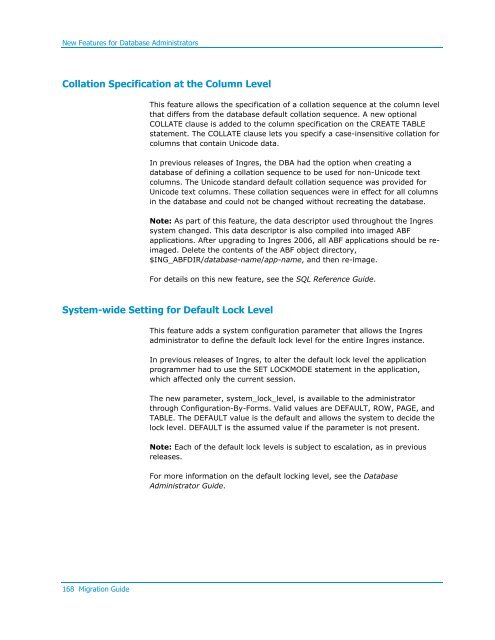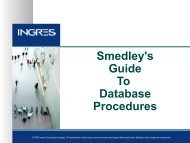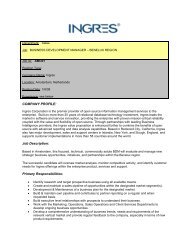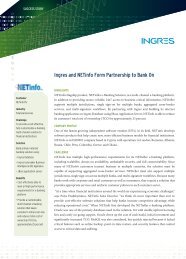- Page 1 and 2:
Ingres ® 9.2 Migration GuideING-92
- Page 6 and 7:
Run VMSINSTAL .....................
- Page 8 and 9:
BEFORE Triggers....................
- Page 10 and 11:
Increased Maximum Size of Character
- Page 13 and 14:
Chapter 1: Planning the Upgrade Thi
- Page 15:
Upgrade TypesUpgradedb MethodThe up
- Page 19:
Required Installations for Upgradin
- Page 24:
How You Move an Existing Developmen
- Page 27 and 28:
How You Prepare Your ApplicationsRe
- Page 29 and 30:
How You Load Databases and Applicat
- Page 31 and 32:
How You Load Databases and Applicat
- Page 33 and 34:
How You Load Databases and Applicat
- Page 35 and 36:
How You Prepare for Development Ins
- Page 37 and 38:
How You Prepare for Development Ins
- Page 39 and 40:
Testing Applications and Procedures
- Page 41:
How You Practice the UpgradeHow You
- Page 44 and 45:
How You Upgrade Using the Upgradedb
- Page 46 and 47:
How You Upgrade Using the Upgradedb
- Page 48 and 49:
How You Upgrade Using the Upgradedb
- Page 50 and 51:
How You Upgrade Using the Upgradedb
- Page 52 and 53:
How You Upgrade Using the Upgradedb
- Page 56 and 57:
How You Perform an Upgrade Using Un
- Page 58 and 59:
How You Perform an Upgrade Using Un
- Page 60 and 61:
How You Perform an Upgrade Using Un
- Page 62 and 63:
How You Perform an Upgrade Using Un
- Page 64 and 65:
How You Perform an Upgrade Using Un
- Page 66 and 67:
How You Perform an Upgrade Using Un
- Page 68 and 69:
How You Perform an Upgrade Using Un
- Page 70 and 71:
How You Perform an Upgrade Using Un
- Page 72 and 73:
How You Perform an Upgrade Using Un
- Page 74 and 75:
How You Perform an Upgrade Using Un
- Page 77 and 78:
Chapter 5: Troubleshooting Upgraded
- Page 79:
Other Upgradedb ProblemsOther Upgra
- Page 82 and 83:
Considerations When Installing Ingr
- Page 84 and 85:
Application RebuildingApplication R
- Page 86 and 87:
Application RebuildingModifications
- Page 89 and 90:
Appendix A: Upgrading from Ingres 6
- Page 91 and 92:
Considerations for Ingres 6.4Decima
- Page 93 and 94:
Considerations for Ingres 6.4Applic
- Page 95 and 96:
Unload/Reload Procedure for Upgradi
- Page 97 and 98:
How You Upgrade from Ingres 6.4 Usi
- Page 99 and 100:
How You Upgrade from Ingres 6.4 Usi
- Page 101 and 102:
How You Upgrade from Ingres 6.4 Usi
- Page 103 and 104:
How You Upgrade from Ingres 6.4 Usi
- Page 105 and 106:
How You Upgrade from Ingres 6.4 Usi
- Page 107 and 108:
How You Upgrade from Ingres 6.4 Usi
- Page 109 and 110:
How You Upgrade from Ingres 6.4 Usi
- Page 111 and 112:
How You Upgrade from Ingres 6.4 Usi
- Page 113 and 114:
How You Upgrade from Ingres 6.4 Usi
- Page 115 and 116:
Corresponding Parameter NamesIngres
- Page 117 and 118: Corresponding Parameter Names• Th
- Page 119 and 120: Appendix B: Keywords This section c
- Page 121 and 122: Reserved Single KeywordsSQLQUELKeyw
- Page 123 and 124: Reserved Single KeywordsSQLQUELKeyw
- Page 125 and 126: Reserved Single KeywordsSQLQUELKeyw
- Page 127 and 128: Reserved Single KeywordsSQLQUELKeyw
- Page 129 and 130: Reserved Single KeywordsSQLQUELKeyw
- Page 131 and 132: Reserved Double KeywordsSQLQUELKeyw
- Page 133 and 134: Reserved Double KeywordsSQLQUELKeyw
- Page 135 and 136: Reserved Double KeywordsSQLQUELKeyw
- Page 137 and 138: Reserved Double KeywordsSQLQUELKeyw
- Page 139 and 140: Reserved Double KeywordsKeyword Non
- Page 141: Other Reserved KeywordsSQLQUELKeywo
- Page 144 and 145: DBMS Server EnhancementsLOB Locator
- Page 146 and 147: DBMS Server EnhancementsAutomatic S
- Page 148 and 149: DBMS Server EnhancementsIncremental
- Page 150 and 151: DBMS Server EnhancementsIn the FETC
- Page 152 and 153: Connectivity EnhancementsServer Typ
- Page 154 and 155: Connectivity Enhancements.NET Data
- Page 156 and 157: New Features in the DBMS ServerANSI
- Page 158 and 159: Ease of Use EnhancementsAutomatic C
- Page 160 and 161: Connectivity EnhancementsODBC Enhan
- Page 162 and 163: Supportability EnhancementSupport f
- Page 165 and 166: Appendix E: Features Introduced inI
- Page 167: New Features for Database Administr
- Page 171 and 172: Additions to the Visual DBA SuiteVi
- Page 173 and 174: Connectivity EnhancementsConnectivi
- Page 175 and 176: Connectivity EnhancementsUpdatable
- Page 177 and 178: Connectivity EnhancementsIngres .NE
- Page 179 and 180: New Features for LinuxODBC Call-lev
- Page 181 and 182: Changes to Existing FeaturesJDBC Us
- Page 183 and 184: Changes to Existing FeaturesVisual
- Page 185 and 186: Changes to Existing FeaturesNotific
- Page 187 and 188: Changes to Existing FeaturesRegiste
- Page 189 and 190: Changes to Existing FeaturesCREATED
- Page 191: Changes to Existing FeaturesHelp Sy
- Page 194 and 195: Increased Maximum Size of Character
- Page 196 and 197: User-Visible DBA EnhancementsGather
- Page 198 and 199: Internal Performance EnhancementsRe
- Page 200 and 201: Logging System Performance Improvem
- Page 202 and 203: JDBC EnhancementsUnavailable Featur
- Page 204 and 205: New Character Sets to Support Euro
- Page 207 and 208: Appendix G: Features Introduced inI
- Page 209 and 210: Sort EnhancementsDMF Sort Enhanceme
- Page 211 and 212: Large Cache SupportLarge Cache Supp
- Page 213 and 214: Optimizer and Optimizedb Enhancemen
- Page 215 and 216: New SQL FunctionalityNew SQL Functi
- Page 217 and 218: Extended Date SupportAggregate Func
- Page 219 and 220:
Query Optimization and Execution En
- Page 221 and 222:
Ingres ICE FeaturesIngres ICE Secur
- Page 223:
OpenAPI EnhancementsOpenAPI Enhance
- Page 226 and 227:
dmf sort • 209 dynamic write behi
- Page 228:
features in 2.5 • 219 startup •
















